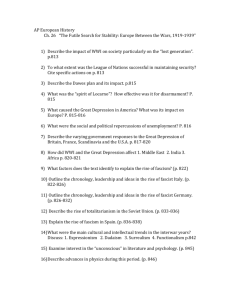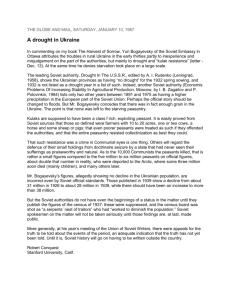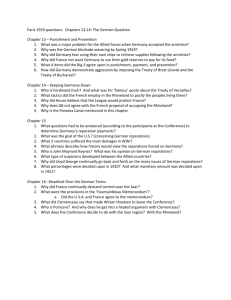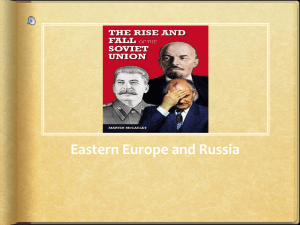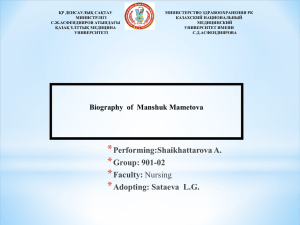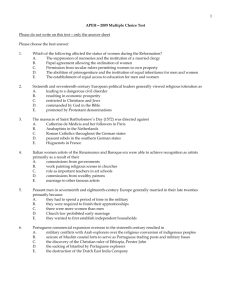Chapter 26 + 27 Study Guide Following the Paris peace treaties, all
advertisement
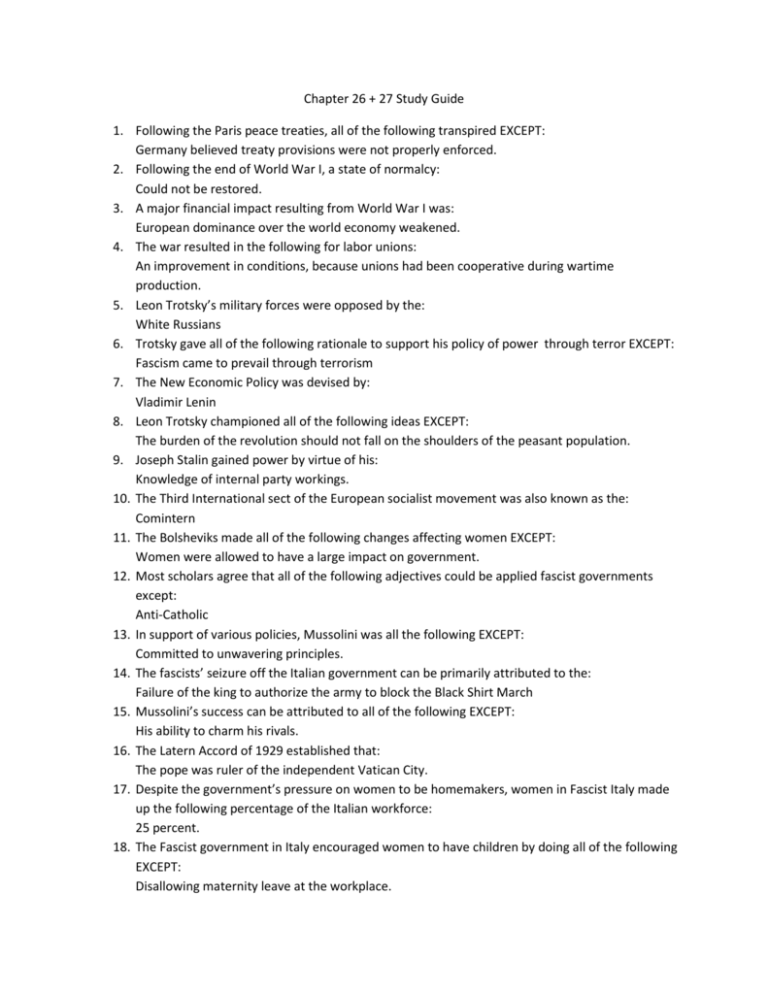
Chapter 26 + 27 Study Guide 1. Following the Paris peace treaties, all of the following transpired EXCEPT: Germany believed treaty provisions were not properly enforced. 2. Following the end of World War I, a state of normalcy: Could not be restored. 3. A major financial impact resulting from World War I was: European dominance over the world economy weakened. 4. The war resulted in the following for labor unions: An improvement in conditions, because unions had been cooperative during wartime production. 5. Leon Trotsky’s military forces were opposed by the: White Russians 6. Trotsky gave all of the following rationale to support his policy of power through terror EXCEPT: Fascism came to prevail through terrorism 7. The New Economic Policy was devised by: Vladimir Lenin 8. Leon Trotsky championed all of the following ideas EXCEPT: The burden of the revolution should not fall on the shoulders of the peasant population. 9. Joseph Stalin gained power by virtue of his: Knowledge of internal party workings. 10. The Third International sect of the European socialist movement was also known as the: Comintern 11. The Bolsheviks made all of the following changes affecting women EXCEPT: Women were allowed to have a large impact on government. 12. Most scholars agree that all of the following adjectives could be applied fascist governments except: Anti-Catholic 13. In support of various policies, Mussolini was all the following EXCEPT: Committed to unwavering principles. 14. The fascists’ seizure off the Italian government can be primarily attributed to the: Failure of the king to authorize the army to block the Black Shirt March 15. Mussolini’s success can be attributed to all of the following EXCEPT: His ability to charm his rivals. 16. The Latern Accord of 1929 established that: The pope was ruler of the independent Vatican City. 17. Despite the government’s pressure on women to be homemakers, women in Fascist Italy made up the following percentage of the Italian workforce: 25 percent. 18. The Fascist government in Italy encouraged women to have children by doing all of the following EXCEPT: Disallowing maternity leave at the workplace. 19. What was the political character of France’s Chamber of Duties? Staunchly Conservative 20. France formed a pact with which three Eastern Europeam countries, known as the Little Entente? Czechoslovakia, Romania, and Yugoslavia 21. In 1923, French Forces occupied the following region in the German Rhineland, in attempt to force Germany to make reparations for World War I: Ruhr 22. A conservative leader in Great Britain, Stanley Baldwin tried to remedy the country’s economic woes by: Both A and B 23. In 1926, the following labor group started a strike that soon found sympathetic workers in other trades: Coal Miners 24. The following can be said about the successor states in Eastern Europe EXCEPT: All the new states were primarily urban nations. 25. The new Poland was constructed from all of the following countries EXCEPT: Lithuania 26. Which successor state avoided a self-imposed authoritarian government? Czechoslovakia 27. Who was the Hungarian communist Stalin had executed after the fall of the Hungarian Soviet Republic? Bela Kun 28. Royal dictatorships were imposed in: Yugoslavia, Bulgaria, Romania, and Greece 29. In the 1920s, German politics parties were mainly: Dissatisfied with the treaty and wanted to revise it. 30. The Weimar constitution: Provided for a proportional representation. 31. In 1920, an armed insurrection took place in Berlin. The insurrection is also referred to as the: Kapp Putsch 32. The U.S. dollar increased in value in comparison to the German mark by what percentage, from 1914 to 1921? 1,500 percent 33. The Nazis’ Twenty-Five Points progam called for all of the following EXCEPT: The replacement of small retail shops with large department stores. 34. Which of the following was NOT a factor that contributed to the intense severity and the extended length of the Great Depression in Europe? Increasing governmental control of economic affairs 34. Most money the Allies collected in war reparations went to: The United States 35. In 1924 this plan reorganized the administration and transfer of reparations, which, in turn, smoothed the debt repayments to the United States: Dawes Plan 36. The Wall Street crash of October 1929 was the result of: Virtually unregulated financial speculation 37. In the summer of 1932 this, ended the era of reparations: Lausanne Conference 38. One result of the economic crisis of the depression was the emergence of a body of economic thought first set forth in 1936 in General Theory of Employment, Interests, and Money by: John Maynard Keynes 39. Which of the following did the British National Government NOT do to attack the depression? Eliminated all import tax 40. The 1936 Popular Front government of France consisted of an alliance of all of the following political parties EXCEPT the: Monarchists 41. The purpose of this coalition was to preserve the republic and press for social reform: Popular Front 42. All of the following is true of Blum’s labor policy Except: He firmly resolved no to devalue the franc and held to his promise 43. The outflow of foreign capital from Germany beginning in 1928 undermined the brief prosperity and resulted in crisis ending: Parliamentary government 44. German unemployment from March 1930 to March 1932: More than doubled 45. By 1993, the Nazi storm troopers (SA) had: 1 million members 46. The 1932 presidential elections resulted in: Hindenburg’s dismissal of Bruning 47. Adolph Hitler became Chancellor of Germany: By legal means 48. Support for Hitler was particularly strong among groups such as: Farmers, war veterans, and the young 49. All of the following were steps toward Hitler’s consolidation of power EXCEPT the: Creation of an alliance with centrist parties 50. The suspending of civil liberties and arrests of communists or alleged communists was a direct result of: The Reichstag fire 51. The 1935 Nuremburg laws: Stripped German Jews of their citizenship 52. Nazi policy called for German women to do all of the following EXCEPT: Occupy key positions in the German government 53. The fascists had promised to stabilize Italian: Both social and economic life 54. Mussolini desperately sought to make Italy self- sufficient with this key product: Wheat 55. From the mid-1920s, Italian labor unions: Lost both the right to strike and the right to pursue independent economic goals 56. One purpose of the Institute for Industrial Reconstruction was: To extend loans to businesses that were in financial difficulty 57. What response did the League of Nations take after Italy’s 1935 invasion of Ethiopia? The League imposed economic sanctions, urging members to not purchase Italian goods 58. Under fascism, Italy saw all of the following EXCEPT: More rights and freedoms for property owners 59. While the capitalist economies of Western Europe floundered in the Great Depression, the Soviet Union undertook: A tremendous industrial advance 60. Between 1928 and 1940, Soviet industrial production: Rose dramatically 61. Government- set prices for grain in the Soviet Union resulted in all of the following EXCEPT: The stabilization of the rural economy 62. All of the following is true of collectivization EXCEPT: Children of peasants were treated as equals and taught to view their parents as traitors to the Soviet Union 63. The Soviet Communist Party was _______ in its ideology Atheist 64. Between 1928 and 1932 approximately, _______ million peasants left the countryside, a migration unprecedented in European history. 12 65. Soviet citizens survived for all of these reasons EXCEPT: People often hid most of their supplies from the Soviet officers 66. Many foreign contemporaries looked at the Soviet economic experiment: Naively 67. The pretext for the onset of this was the assassination of Sergei Kirov on December 1, 1934: The Great Purges


